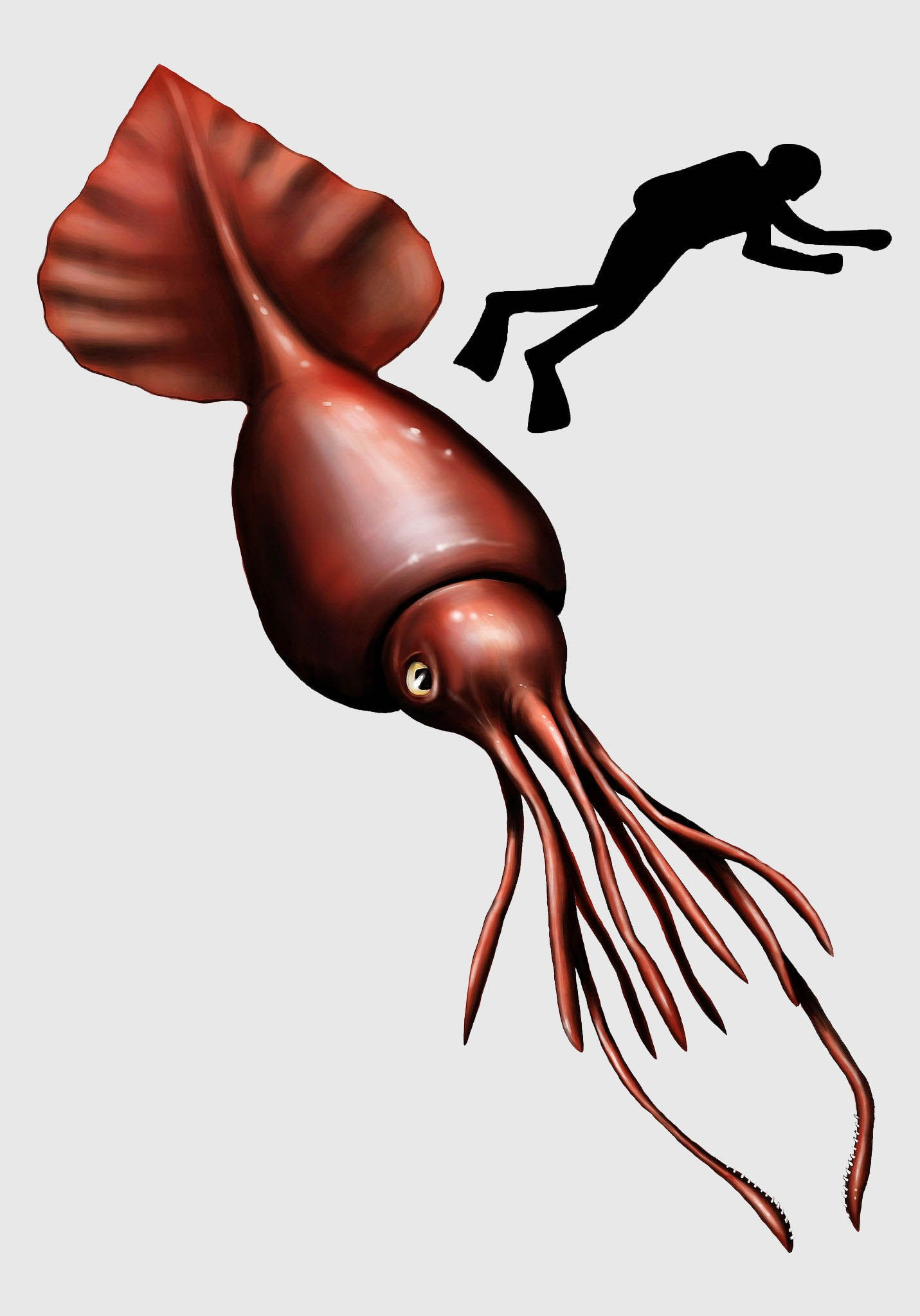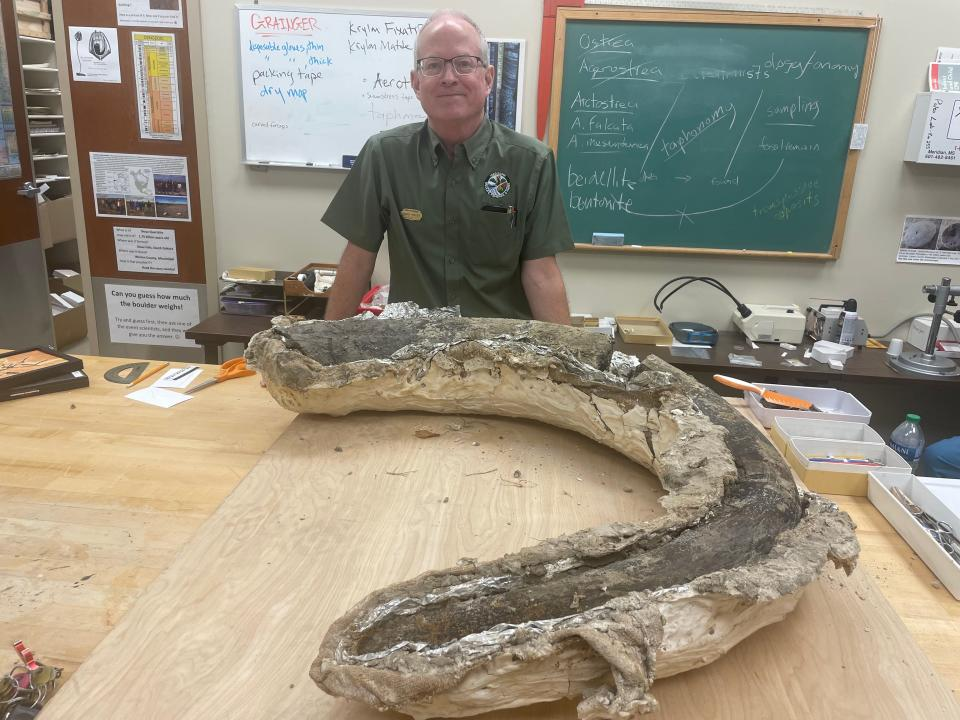The colossal squid, a true marvel of the deep sea, has fascinated scientists and explorers for centuries due to its elusive nature and impressive size. Known scientifically as Mesonychoteuthis hamiltoni, this gigantic cephalopod can measure up to 23 feet in length and, astonishingly, can weigh over half a ton. Recently, the Schmidt Ocean Institute made headlines with a groundbreaking discovery: the first confirmed footage of a juvenile colossal squid filmed alive in its natural habitat, nearly 2,000 feet beneath the ocean’s surface. This momentous event marks a pivotal advancement in cephalopod science, deepening our understanding of these magnificent creatures and their mysterious lives. As deep sea discoveries continue to unfold, the colossal squid remains a shining example of the wonders that still await us in our vast oceans.
In the realm of deep-sea wonders, the giant squid stands as one of the ocean’s most enigmatic inhabitants, captivating our imagination with its sheer scale and mysterious behavior. Also referred to as the giant cephalopod, this enormous mollusk belongs to a group of fascinating creatures known for their intelligence and adaptability. The recent sighting of a juvenile giant squid by researchers aboard the Falkor (too) underscores the importance of ongoing exploration in our effort to understand these deep-sea dwellers. With their resemblance to the ethereal glacial glass squid, both species showcase the incredible diversity of life in the depths of our oceans. As we delve deeper into the abyss, every new revelation about these fascinating squid brings us closer to unraveling the secrets of deep-sea ecology.
The Elusive Colossal Squid: A Deep Sea Mystery Unveiled
For over a century, the colossal squid has fascinated marine biologists and ocean explorers alike, remaining one of the deep sea’s most elusive mysteries. Known primarily through remnants found in whale stomachs, and a handful of dying adults observed by fishermen, this creature of legend can reach astonishing lengths of up to 23 feet (7 meters). Recent discoveries from the Schmidt Ocean Institute’s research vessel Falkor (too) have shed new light on this enigmatic cephalopod. On March 9, researchers filmed a juvenile colossal squid, measuring about a foot (30 centimeters), showcasing the potential for more extensive studies on these elusive creatures that have remained largely invisible to human eyes for generations.
The significance of the discovery cannot be understated; it marks the first confirmed footage of the colossal squid (Mesonychoteuthis hamiltoni) in its natural habitat, filmed at an astounding depth of around 2,000 feet (610 meters). This juvenile’s observable traits provide essential insights into the colossal squid’s behavior and ecology, complementing efforts to catalog deep-sea biodiversity. As scientists delve deeper into the mysteries of these creatures, understanding their role in marine ecosystems could also help illuminate broader patterns of life beneath the surface.
The observation was made possible by utilizing ROVs like SuBastian, specifically designed for deep-sea exploration. These remotely operated vehicles are invaluable tools in studying the colossal squid and similar elusive species. This discovery coincided with a significant global initiative—the Ocean Census—to catalogue deep-sea biodiversity, emphasizing the importance of continued exploration and research in these unexplored regions. The sighting of the juvenile colossal squid not only enriches our understanding of cephalopod science but also serves as a reminder of the vast mysteries that remain hidden in the depths.
Juvenile Colossal Squids and Their Distinct Characteristics
Juvenile colossal squids possess remarkable features that distinguish them from their counterparts, such as the glacial glass squid (Galiteuthis glacialis), recently filmed by the Falkor (too). While both species exhibit transparent bodies and long tentacles, the juvenile colossal squid’s arms are notably equipped with hooks in their midsections, setting them apart in the cephalopod family. Understanding these distinctions is crucial for marine researchers as they strive to document the behavior and ecological roles of these intriguing mollusks.
The ability to observe a juvenile colossal squid in its natural habitat allows scientists to gather invaluable data regarding their growth, development, and adaptability to the extreme conditions of the deep sea. With the heaviest invertebrate weighing up to 1,100 pounds and possessing eyes the size of basketballs, the journey from juvenile to adult colossal squid remains a fascinating subject of research in modern cephalopod science.
Another interesting aspect pertains to the visibility and rarely captured behavior of juvenile colossal squids. Unlike the ghostly glacial glass squid known for its elegant ‘cockatoo pose,’ juvenile colossal squids often evade observation due to their habitat preference and behavioral patterns. This discrepancy in visibility opens avenues for research into the adaptations that allow the colossal squid to thrive in such extreme depths, showcasing the diverse strategies employed by marine life to survive harsh oceanic environments.
Glacial Glass Squid: The Other Recent Discovery
In addition to the groundbreaking sighting of the juvenile colossal squid, the Schmidt Ocean Institute also captured the first-ever footage of the glacial glass squid in the Southern Ocean, showcasing yet another incredible deep-sea discovery. Known for its translucent body and striking ‘cockatoo pose,’ this elusive squid exemplifies the vast diversity found within cephalopod species. The glacial glass squid’s ability to blend into its surroundings, combined with its unique behavior, adds another layer to our understanding of life in the ocean’s depths.
These recent sightings underline the importance of deep-sea explorations conducted by the Schmidt Ocean Institute and similar organizations. Through the development of advanced technology and commitment to ocean research, scientists can uncover the secrets of marine creatures like the glacial glass squid, revealing critical insights into their unique adaptations, life cycles, and ecological roles. Such discoveries not only delight enthusiasts of cephalopod science but also broaden our understanding of the interconnectedness of ocean biodiversity.
Capturing live footage of the glacial glass squid provides an unparalleled opportunity for researchers to study its behavior and habitat. Previously shrouded in mystery, these squids have now been documented in their natural surroundings, which can offer valuable data for ongoing research into their life processes and interactions within their ecosystem. Furthermore, as the Schmidt Ocean Institute explores various oceanic phenomena—like ice calving revealing ancient ecosystems—the implications for marine conservation and understanding climate impacts on biodiversity become increasingly significant.
The Role of Remote Operated Vehicles in Deep Sea Research
The advent of remote-operated vehicles (ROVs) has revolutionized the exploration of deep-sea environments, proving essential in studying colossal squids and other elusive marine life. Vessels like the Schmidt Ocean Institute’s SuBastian not only provide researchers with the ability to observe deep-sea species in their natural habitats but also facilitate the collection of crucial data regarding their behavior and ecology. These technological advancements enable marine scientists to gather evidence that was once nearly impossible due to the inaccessibility of deep ocean environments.
As remotely operated vehicles navigate extreme depths, the integration of advanced imaging technology and real-time data collection capabilities allow for precise monitoring of various marine species, including cephalopods. These innovations lead to deeper insights into the complex lives of creatures that occupy the deep ocean, contributing to the broader understanding of oceanic biodiversity and the challenges faced by these species due to changing ocean conditions.
The capabilities provided by ROVs also enhance collaborative efforts like the Ocean Census, which aims to document species across the world’s oceans. By utilizing vehicles like SuBastian, researchers can efficiently conduct explorations and further our knowledge about the vast ecosystems underlying the ocean surface. As more data becomes available, the potential to inform conservation efforts improves, emphasizing the necessity of incorporating technological advancements in marine biology to address the critical needs of ocean health and sustainability.
Conservation Efforts for Deep Sea Species
As remarkable as the discoveries of the juvenile colossal squid and glacial glass squid are, they also serve as a stark reminder of the importance of conservation efforts for deep-sea species. Many of these creatures inhabit delicate ecosystems threatened by climate change, ocean acidification, and human activities such as deep-sea mining and overfishing. Understanding their significance within marine ecosystems is crucial for advocating effective conservation strategies aimed at protecting their habitats.
Collaborative endeavors, like those undertaken by the Schmidt Ocean Institute, are integral to raising awareness about the unique challenges that deep-sea species face. By documenting and promoting their findings, scientists can engage the public and policymakers in conversations around ocean conservation, emphasizing how vital it is to protect these lesser-known marine animals that contribute significantly to the health of global ecosystems.
Through increased research and exploration, the mysteries of deep-sea species—such as the colossal squid and its kin—can help inspire conservation initiatives that prioritize the protection of these enigmatic creatures and their habitats. As more information becomes available regarding their ecological roles and vulnerabilities, researchers can develop tailored strategies that address the decline in deep-sea populations, fostering a sustainable coexistence between humans and the extraordinary biodiversity present in our oceans.
A Century of Colossal Squid Research
The recent excitement surrounding the discovery of the juvenile colossal squid coincides with the 100-year anniversary of its formal identification. Over the past century, research on this remarkable creature has evolved significantly, revealing a patchwork of knowledge built on sporadic sightings, anecdotal accounts, and scientific investigations. This milestone serves not only as a celebration of progress in cephalopod science but also as an opportunity to reflect on the ongoing challenges and mysteries that remain in understanding these colossal invertebrates.
As technology continues to advance, the potential to deepen our understanding of the colossal squid’s biology and ecology grows exponentially. With each new discovery contributing to the existing body of knowledge, researchers are better equipped to unravel the complexities of these deep-sea giants, paving the way for further investigations into their behavior, interactions with other marine species, and response to environmental changes.
The centenary of the colossal squid’s formal identification also highlights the ongoing need for exploration in unchartered ocean territories. As the Schmidt Ocean Institute and other organizations continue their research efforts, the excitement surrounding new discoveries raises awareness and underscores the necessity for continued funding and support for marine research. The cumulative findings surrounding the colossal squid not only foster appreciation for deep-sea biodiversity but also remind us of the vast unexplored territories that still harbor countless secrets waiting to be uncovered.
The Future of Deep Sea Exploration
As we look towards the future of deep-sea exploration, the excitement surrounding discoveries like the juvenile colossal squid and glacial glass squid unveils the vast potential that lies beneath the ocean surface. Innovations in technology, particularly the use of ROVs and advanced imaging systems, pave the way for new research avenues, enabling scientists to engage in meaningful exploration that enhances our understanding of marine biodiversity. With every venture into the deep, the potential to uncover new species and environmental dynamics grows, leading us closer to unlocking the mysteries that the ocean holds.
The future of deep-sea exploration also hinges upon collaborative efforts among researchers, conservationists, and policymakers. By fostering an environment where knowledge-sharing and technological advancement go hand in hand, there is a greater chance of advancing marine science and generating impactful conservation strategies. The discoveries made by institutions like the Schmidt Ocean Institute illustrate the necessity of continued support and investment in deep-sea research to ensure a sustainable future for the ecosystems that thrive in the depths.
As our oceanic understanding deepens, the implications extend beyond the scientific community to encompass broader themes of environmental stewardship and the protection of biodiversity. Increased collaboration and advocacy efforts can inspire a greater appreciation for the ocean’s wonders, ultimately leading to more efforts directed towards conservation initiatives that prioritize deep-sea species and their habitats. Success in this research will pave the way for future generations of scientists and conservationists, dedicated to safeguarding the delicate balance of life that exists in the uncharted territories of the deep.
Frequently Asked Questions
What is the significance of the recent colossal squid discoveries by the Schmidt Ocean Institute?
The recent discoveries of the colossal squid by the Schmidt Ocean Institute mark a milestone in cephalopod science, providing the first confirmed footage of a juvenile colossal squid (Mesonychoteuthis hamiltoni) in the wild. This historic event, filmed using the remotely operated vehicle SuBastian, offers valuable insights into the behaviors and habitats of these elusive deep-sea creatures.
How does the juvenile colossal squid differ from the glacial glass squid?
While both the juvenile colossal squid and glacial glass squid exhibit translucent bodies and long tentacles, they are distinguishable by their features. The colossal squid has arms with hooks in their midsections, whereas the glacial glass squid lacks these hooks. This difference highlights the unique adaptations of each species within the intriguing world of deep-sea cephalopods.
What depths do colossal squids inhabit and how are they studied?
Colossal squids can be found at depths of around 2,000 feet (609 meters) in the ocean. Their extreme habitats make them challenging to study, which is why researchers use remotely operated vehicles, such as the Schmidt Ocean Institute’s SuBastian, to observe and capture footage of these giant invertebrates in their natural environment.
Why are colossal squids considered elusive creatures in deep sea discoveries?
Colossal squids are deemed elusive due to their rarity in sightings and the extreme depths at which they reside, making direct observations extraordinarily difficult. Until the recent filming by the Schmidt Ocean Institute, most knowledge about these squids came from fragments found in whale stomachs and a few captured specimens, which did not provide extensive behavioral insights.
What advancements in cephalopod science have been made thanks to the Schmidt Ocean Institute?
The Schmidt Ocean Institute has significantly advanced cephalopod science through its research expeditions, including the recent successful capture of footage from both the juvenile colossal squid and the glacial glass squid. These discoveries not only enhance our understanding of squid biology but also contribute to global efforts in cataloging deep-sea biodiversity.
How does the colossal squid compare to other giant squids in terms of size and weight?
The colossal squid is known to be the largest and heaviest invertebrate on Earth, with the potential to weigh up to 1,100 pounds (500 kilograms). This surpasses many other giant squid species, making the colossal squid an extraordinary subject of study in the realm of deep-sea biology and mysteries.
What role does the Schmidt Ocean Institute play in exploring deep-sea squid species?
The Schmidt Ocean Institute plays a vital role in exploring deep-sea squid species through advanced technology and research expeditions. Their initiatives not only capture rare footage of creatures like the colossal squid and glacial glass squid but also help enlighten the scientific community about the biodiversity of oceanic ecosystems.
| Key Points |
|---|
| The colossal squid is elusive and was mainly known from fragments found in whale stomachs. |
| It measures about 23 feet (7 meters) long and can weigh over half a ton (453 kilograms). |
| Recent footage captured a juvenile colossal squid for the first time on March 9 by Schmidt Ocean Institute’s ROV SuBastian. |
| The squid was filmed alive at about 2,000 feet (609 meters) deep near the South Sandwich Islands. |
| Colossal squid (Mesonychoteuthis hamiltoni) are the heaviest invertebrates on Earth with eyes the size of basketballs. |
| The sighting coincided with the 100-year anniversary of the species’ formal identification. |
| There was also a recent sighting of a glacial glass squid (Galiteuthis glacialis) filmed alive, marking a significant discovery rate. |
| Experts verified the identities of the squids based on the footage captured during the expedition. |
| The extreme habitat of colossal squids poses significant challenges for human exploration, making ROVs ideal for study. |
Summary
The colossal squid, a mysterious inhabitant of the deep ocean, has been the subject of fascination for over a century. Recent advancements in exploration technology have provided scientists with the first confirmed footage of a juvenile colossal squid in its natural habitat, revealing remarkable insights into the biology of this impressive creature. As research continues, further discoveries like these help to unravel the mysteries of the deep sea, ensuring the colossal squid remains a captivating subject for marine biology enthusiasts.



